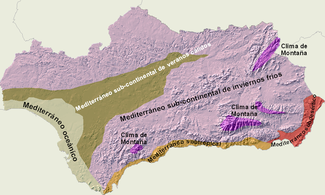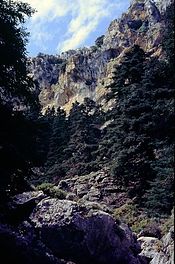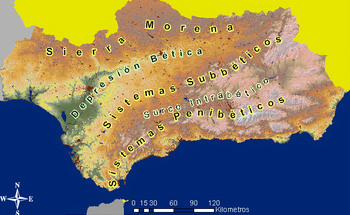[edit] Climate

Locations of the principal Andalusian climate types.[18]

Andalusian firs, Sierra de las Nieves
Annual rainfall in the Sierra de Grazalema has been measured as high as 4,346 millimetres (171.1 in) in 1963, the highest ever recorded for any location in Iberia.[24] Andalusia is also home to the driest place in continental Europe, the Cabo de Gata, with only 117 millimetres (4.6 in) of rain per year.
In general, as one goes from west to east, away from the Atlantic, there is less precipitation.[24] "Wet Andalusia" includes most of the highest points in the region, above all the Sierra de Grazalema but also the Serranía de Ronda in western Málaga. The valley of the Guadalquivir has moderate rainfall. The Tabernas Desert in Almería, Europe's only true desert, has less than 75 days with any measurable precipitation, and some particular places in the desert have as few as 50 such days. Much of "dry Andalusia" has more than 300 "sunny" days a year.
The average temperature in Andalusia throughout the year is over 16 °C (61 °F). Averages in the cities range from 15.1 °C (59.2 °F) in Baeza to 18.5 °C (65.3 °F) in Málaga.[25] Much of the Guadalquivir valley and the Mediterranean coast has an average of about 18 °C (64 °F). The coldest month is January when Granada at the foot of the Sierra Nevada experiences an average temperature of 6.4 °C (43.5 °F). The hottest are July and August, with an average temperature of 28.5 °C (83.3 °F) for Andalusia as a whole. Córdoba is the hottest provincial capital, followed by Seville.[26]
The Guadalquivir valley has experienced the highest temperatures recorded in Europe, with a maximum of 46.6 °C (115.9 °F) recorded at Córdoba and Seville.[27] The mountains of Granada and Jaén have the coldest temperatures in southern Iberia, but do not reach continental extremes (and, indeed are surpassed by some mountains in northern Spain). In the cold snap of January 2005, Santiago de la Espada (Jaén) experienced a temperature of −21 °C (−6 °F) and the ski resort at Sierra Nevada National Park—the southernmost ski resort in Europe—dropped to −18 °C (−0 °F). Sierra Nevada Natural Park has Iberia's lowest average annual temperature, (3.9 °C (39.0 °F) at Pradollano) and its peaks remain snowy practically year-round.
[edit] Terrain
Mountain ranges affect climate, the network of rivers, soils and their erosion, bioregions, and even human economies insofar as they rely on natural resources.[28] The Andalusian terrain offers a range of altitudes and slopes. Andalusia has the Iberian peninsula's highest mountains and nearly 15 percent of its terrain over 1,000 metres (3,300 ft). The picture is similar for areas under 100 metres (330 ft) (with the Baetic Depression), and for the variety of slopes.The Atlantic coast is overwhelmingly beach and gradually sloping coasts; the Mediterranean coast has many cliffs, above all in the Malagan Axarquía and in Granada and Almería.[29] This asymmetry divides the region naturally into Upper Andalusia (two mountainous areas) and Lower Andalusia (the broad basin of the Guadalquivir).[30]
The Sierra Morena separates Andalusia from the plains of Extremadura and Castile–La Mancha on Spain's Meseta Central. Although sparsely populated, this is not a particularly high range, and its highest point, the 1,323-metre (4,341 ft) peak of La Bañuela in the Sierra Madrona, lies outside of Andalusia. Within the Sierra Morana, the gorge of the Despeñaperros forms a natural frontier between Castile and Andalusia.
The Baetic Cordillera consists of the parallel mountain ranges of the Cordillera Penibética near the Mediterranean coast and the Cordillera Subbética inland, separated by the Surco Intrabético. The Cordillera Subbética is quite discontinuous, offering many passes that facilitate transportation, but the Penibético forms a strong barrier between the Mediterranean coast and the interior.[31] The Sierra Nevada, part of the Cordillera Penibética in the Province of Granada, has the highest peaks in Iberia: El Mulhacén at 3,478 metres (11,411 ft) and El Veleta at 3,392 metres (11,129 ft).
Lower Andalusia, the Baetic Depression, the basin of the Guadalquivir, lies between these two mountainous areas. It is a nearly flat territory, open to the Gulf of Cádiz in the southeast. Throughout history, this has been the most populous part of Andalusia


No comments:
Post a Comment